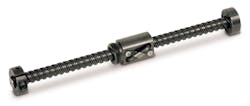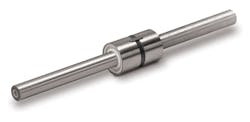Calculating the Life of Ball and Roller Screw Actuators
Estimating how long a piece of equipment will last in an application is critical information in the specification process. This step-by-step guide examines how to estimate the life of electric actuators that use either ball or roller screws in applications with constant or varying (changing) loads. In addition, it explains how to calculate life in units of hours, days, or years, and how to compare the expected life of two different actuators.
Load is just one factor that affects an actuator’s service life. Factors that shorten an actuator’s life or lead to premature failure include incorrect mounting/alignment, lubrication starvation, high temperatures, and other environmental extremes. Consider each of these factors to ensure a long service life and maintenance-free operation for your application.
Definitions
Dynamic load rating (DLR) is a constant load (in direction and magnitude) which lets a ball-bearing device reach 1,000,000 revolutions of rated life. DLR’s magnitude typically depends on screw diameter, screw lead, and the number of recirculating rolling elements (balls or rollers) inside the nut that simultaneously carry the load. DLR is also known referred to as C, and is typically provided by manufacturers for ball and roller nuts.
Constant loads remain unchanged along the full working cycle
Varying loads change during the working cycle. If an application has a varying load, it becomes necessary to calculate the equivalent dynamic load for life calculations.
Equivalent dynamic load (or Pe) is a dynamic load acting on the screw axially and centrally, which, if applied constantly, would have the same effect on screw life as all of the actual loads. And if the load is constant, then equivalent load = actual load.
“L10” Life is the life of a ball or roller nut at which 10% of all its balls or rollers can be expected to suffer a classical fatigue failure (or alternatively, the life at which 90% will still be operating). Outside the USA, it may be referred to as “B10” life. L10 for a group of identical screw actuators operating under the same conditions is the period within which 10% of them can be expected to fail. This means 90% of the actuators have the statistical probability of surviving that long.
L10 life does not account for any other mode of failure such as lubrication starvation or incorrect mounting.
L10 is a theoretical life estimate based on statistics, so it is no guarantee of performance but a good predictor of expected life.
SH: Estimating Life with a Constant Load
To estimate life with a constant load, the underlying formula that defines this value is:
L10 = (C/Pe)3 × l
L10 Travel life in millions of units (in or mm), where:
C = Dynamic load rating (lbf) or (N)
Pe = Equivalent load (lbf) or (N)
l = Screw lead (in/rev) or (mm/rev)
If the load is constant across all movements, then the equivalent load = actual load.
If the load varies across moves, then you must calculate an equivalent load.
Be sure to use the same units in both parts of the equation. Use the same units (lbf or N or kN) as DLR.
Example of calculating constant-load life
Given the following values for an application,
C = 10,000 lbf
Pe = 5,000 lbf
l = 5 mm
Calculate the travel life of the actuator.
The underlying formula defining this value is:
L10 = ((C)/Pe)3 × l
L10 = (10,000/5,000)3 × 5
= (2 )3 × 5 = 8 × 5
= 40
= 40 million mm or (40,000 m)
Estimating Life with a Varying Load
As explained earlier, when the load varies during the working cycle, it is necessary to calculate the equivalent dynamic load (Pe). Use the calculation below when the load is not constant throughout the entire stroke. In cases where there is only minor variation in loading, use greatest load for life calculations.
Pe = ((L1(P1)3 + L2(P2)3 + L3(P3)3 + Ln(Pn)3)/L)1/3
Where:
Pe = Equivalent load (lb) or (N)
Pn= Each increment at different load (lb) or (N)
L = Total distance traveled per cycle (extend and retract strokes)
= (L1 + L2 + L3 + Ln)
Ln = Each increment of stroke (in) or (mm) at different load
Then use the calculated Pe in the life calculation shown previously.
Example of calculating varying-load life
Given the following values for an application:
w C (DLR) = 10,000 lbf
w Screw Lead (l) = 5 mm/rev
wComplete Motion Cycle:
Move +125 mm (L1) with 500 lb load (P1)
Move +25 mm (L2) with 5,000 lb load (P2)
Move −150 mm (L3) with 500 lb load (P3)
Total move = 300 mm
Then use:
Pe =((L1(P1)3 + L2(P2 )3 + L3(P3 )3 + Ln(Pn )3)/L)1/3
= ((125 × (500)3 + 25 × (5,000)3 + 150 × (500)3)/300)1/3
= ((15,625,000,000 + 3,125,000,000,000 + 18,750,000,000)/300)1/3
= (10,531,250,000)1/3
Pe = 2,192 lbf
Note: 2,192 lbf is less than half a full load 5,000 lbf.
Use this formula to estimate life:
L10 = (C/Pe)3 × l
Travel life in millions of units (in) or (mm), where:
C = 10,000 lbf
Pe = 2,192 lbf (Equivalent Load)
l = 5 mm/rev
So:
L10 = (10,000/2,192)3 × 5 = (4.56)3 × 5 = 94.95 × 5
= 474.75 = 474.75 million mm or 474,750 m
Note: This simple example demonstrates that taking varying load into account yields more than 10 times the travel life compared to using a full load. When varying loads are ignored and the calculation is simplified to use a constant load of 5,000 lbf (to be conservative or to save time), the rounding error can be large enough to lead to a misguided selection of actuators. So be sure to fully understand if an application involves constant or varying loads.
Calculating Estimated Life in Days and Years
To do this, you need:
L10 life calculation in distance
L = Total distance traveled per cycle (extend + retract stroke)
w Number of cycles per minute (CpM)
w Number of hours operated per day (HpD)
w Number of days of operation per year (DpY)
Then:
Life Estimate in days = (L10/L)/ (CpM × (60 min/hr) × HpD)
Life Estimate in years = (L10/L)/ (CpM × (60 min/hr) × HpD × DpY)
Example of estimating life in years:
From the previous example:
Pe = 2192 lbf)
L10 life calculation in distance = 474,731 m
Total distance traveled in one motion cycle (L) = 300 mm or 0.3m
Customer inputs on how the actuator will be used in service:
w Number of cycles per minute (CpM) = 10
w Number of hours operated per day (HpD) = 2 shifts or 16 hours
w Number of days of operation per year (DpY) = 7 days/week minus holidays = 350
Life estimate in time (years) = (L10/L)/ (CpM × (60 min/hr) × HpD × DpY)
= (474,750/0.3)/ (10 × 60 min/hr ×16 × 350)
= 1,582,500/3,360,000 + 0.472 years
Comparing the Life of Two Actuators
Use the formula below to compare actuators A and B:
Comparing A to B: (DLR A/DLR B)3 × (Screw Lead A/Screw Lead B)
Note: It is best to designate the actuator with the higher DLA as “A”. This formula is valid for comparing: ball vs. roller, size 1 vs. size 2, or manufacturer A vs. manufacturer B.
Example of comparing actuators
Comparing life between two actuators, A and B, with same screw leads
w DLR A (8,000 lbf) and DLR B (4,000 lbf); both have 5 mm lead
To compare A to B:
(8,000/4,000)3 × (5/5) = 23 × 1 = 8
This means Actuator A has eight times the life of Actuator B.
Comparing life between two actuators, A and B, with different screw leads:
w DLR A (8,000 lbf) has a 5 mm lead
w DLR B (4,000 lbf) has 10 mm lead
( 8,000/4,000)3 × (5/10) = 23 × 0.5 = 4
This means product A has an estimated 4 times the life of product B. That is because DLRs are based on one million revs, so screw life must be normalized for different leads!
When determining the life of an actuator in a machine application, it is important to evaluate the effects of loading on the screw. Calculating for constant loads requires a different formula than calculating for varying loads. Besides load, other factors affect how the screw performs inside the actuator, including manufacturing methods, other aspects of actuator design, quality of lubrication, velocity, temperature, wear, corrosion, contamination, and other dynamic elements such as misalignment and vibrations.
The calculations contained in this guide provide a general estimation of actuator life based on statistical data. To ensure long service life of your application, consider these other factors, in addition to load, in your specification analysis.
Please note that the calculations shown in this guide are theoretical life estimates and not a guarantee of actual actuator life.



